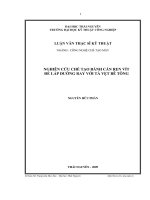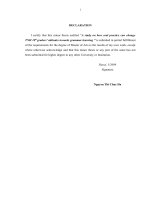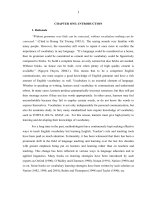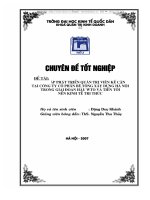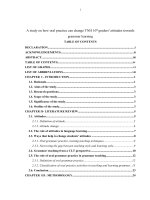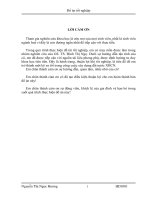Without grammar very little can be conveyed, without vocabulary nothing can be conveyed
Bạn đang xem bản rút gọn của tài liệu. Xem và tải ngay bản đầy đủ của tài liệu tại đây (305.77 KB, 48 trang )
1
CHAPTER ONE: INTRODUCTION
1. Rationale
“Without grammar very little can be conveyed, without vocabulary nothing can be
conveyed.” (Cited in Hoang Tat Truong 1985:1). The saying sounds very familiar with many
people. However, the researcher still wants to repeat it once more to confirm the importance
of vocabulary in any language. “If a language could be considered as a house, then its
grammar could be considered as cement and its vocabulary could be figuratively compared to
bricks. To build a complete house, no only cement but also bricks are needed. Without bricks,
no house can be built, even when plenty of high quality cement is available.” (Nguyen
Huyen, 2004:1). This means that to be a competent English communicator, one must acquire
a good knowledge of English grammar and have a rich amount of English vocabulary as well.
Vocabulary is an essential element of language. Whether in speaking or writing, learners
need vocabulary to communicate and understand others. In many cases, learners produce
grammatically incorrect sentences, but they still get their message across if they use key
words appropriately. In other cases, learners may feel uncomfortable because they fail to
employ certain words, or do not know the words to express themselves. Vocabulary is not
only indispensable for personal communication, but also for academic study. In fact, many
standardized tests require knowledge of vocabulary such as TOFFLE, IELTs, GMAT, etc.
For this reason, learners must give high priority to learning and developing their knowledge
of vocabulary.
For a long time in the past, methodologists have continuously kept seeking effective
ways to teach English vocabulary but learning English. Teacher’s role and teaching tools
have been paid so much attention. Fortunately, it has been witnessed that there has been a
prominent shift in the field of language teaching and learning over the last few decades with
greater emphasis being put on learners and learning rather than on teachers and teaching. This
change has been reflected in various ways in language education and in applied linguistics.
Many books on learning strategies have been introduced by such experts as Oxford (1990),
O’Malley and Charmot (1990), Nunan (1991), Nation (1990) and so on. Some books on
vocabulary learning strategies have been written by such scholars as Nation (1982, 1990, and
2001), Rubin and Thompson (1994) and Taylor (1990), etc.
2
In Vietnam, there has so far been some research on vocabulary learning strategies.
However, research on vocabulary learning strategies employed by students at Hung Vuong
Gifted High School has not been done yet.
As a teacher of English, I have dealt with many questions relating to vocabulary
learning which are raised by my students or among my colleagues. For example, what are the
effective ways of learning vocabulary? How to retain a new word in the mind? Personally I
found it necessary to provide to them successful learning strategies to learn English words.
This is the major reason why this topic interests me.
2. Objectives of the study
The objective of the study is to explore what strategies are commonly used by
students in learning vocabulary and the relationship between the use of vocabulary learning
strategies and the gender, and the field of study.
In order to establish a theoretical framework for the investigation in this thesis, the
literature on language learning strategies, vocabulary learning and related issues is reviewed.
3. Research Questions
The study set out to seek answers to the following research questions:
1. What vocabulary learning strategies are commonly used by the students of Hung
Vuong Gifted High School?
2. Do students’ gender and field of study/major have any impacts on their use of
vocabulary learning strategies?
4. Scope of the study
The study was designed to investigate vocabulary learning strategies which are
employed by the students of HV Gifted High School. It also finds out the differences in the
use of VL strategies among groups of students in relation to gender and their field of study.
The findings obtained from this study was to help improve teaching and learning English in
general and teaching and learning English vocabulary in particular at HV Gifted High
School.
5. Method of the study
3
In order to achieve the aims of the study mentioned above, the quantitative analysis
is the main tool for analyzing the data, which is collected from the questionnaire.
After the data is analyzed and discussed, the findings will be showed and some
conclusions will be drawn and some suggestions will be raised in the thesis.
6. Design of the study
The thesis is divided into four chapters
Chapter 1 includes the rationale, the subjective, the research questions, the scope, the
method and the design of the study.
Chapter 2 covers the information about VL strategy research, some basis concepts
related to learning strategies and vocabulary learning. In addition, learning strategies and
learning strategy classification are reviewed to set up the theoretical framework for the
investigation in the next chapter.
In chapter 3, the study is presented. It includes the context of the study, the research
questions, the research method, the study participants and the findings of the study.
Chapter 4 discusses the use of vocabulary learning strategies by the students of HV
Gifted high school and the differences among groups of students by gender and major.
In the last chapter, chapter 5 contains some conclusions and some limitations of the
study as well as suggestions for further research.
CHAPTER TWO - LITERATURE REVIEW
4
2.1 Introduction
In this chapter, a brief review of learning strategy research is given; some basic
concepts related to learning strategies and vocabulary learning are also presented. In addition,
the classification of learning strategies in general and vocabulary learning strategies in
particular are reviewed to set up the theoretical framework for the investigation in the next
chapter.
2.2. Language learning strategies.
2.2.1 The definitions of learning strategies
It is clearly seen that research on learning strategies in general and language learning
strategies in particular is becoming increasingly popular. So far, there has been no consensus
among the linguists regarding to the definitions of leaning strategies.
According to Nunan (1991:168), “Learning strategies […] are the mental processes
which learners employ to learn and use the target language”. Nunan’s definition restricts
learning strategies only to “mental processes”. Richard et al. (1992:209), offers a broader
definition of learning strategies, that is, learning strategies are intentional behavior and
thoughts that learners make use of during learning in order to better help them understand,
learn and remember new information.” Similarly, Weinstein and Mayer (1986) (in O’
Malley and Charmot 1990:43) have learning facilitation as a goal and are intentional on the
part of the learner. The goal of strategy use is to affect the leaner’s motivational or affective
state, or the way in which the learner selects, acquires, organizes, or integrates new
knowledge.”
Oxford (1990:8) defines learning strategies as “specific actions taken by the learner to
make learning easier, faster, more enjoyable, more self directed, more effective and more
transferable to new situation.”
Ellis defines learning strategies as “the particular approaches or techniques that learner
employs to try to learn an L2.” (1997:76). He furthers explains that learning strategies can be
behavioral or mental and are typically problem - oriented.
Rubin (in Wenden and Rubin 1987:19) is even more explicit when he defines learning
strategies as “any set of operations, steps, plans, routines used by the learner to facilitate the
obtaining, storage, retrieval and use of information, that is, what learner do to learn and do to
regulate their learning.”
5
According to O’Malley and Charmot (1990:1), learning strategies are special ways of
processing information that enhance comprehension, learning, or retention of the
information” or in their other words learning strategies are the “ special thoughts or behaviors
that individuals use to help them comprehend, learn, or retain new information.”
Obviously, learning strategies are defined in different words and from different
perspectives such as cognitive, social or pragmatic. Therefore, researchers worked out the
taxonomy of learning strategies instead of defining them. This can be seen in the following
part.
2.2.2 The characteristics of learning strategies
Learning strategies are techniques, approaches or deliberate actions that students take
in order to facilitate the learning and recall of both linguistic and content information and to
make learning easier, faster, more enjoyable, more self directed, more effective, and more
transferable to new situations.
Wenden and Rubin (1987: 7-8) claimed that learning strategies were composed of the
following components:
Components of learning strategies
1. They are specific actions or techniques.
2. They can be observable/ behaviourable or non-observable/ mental.
3. They are problem-oriented.
4. They can contribute directly or indirectly to learning.
5. They may be consciously employed and became automatized.
6. They are changeable.
Table 1: Components of learning strategies
Source: Wenden and Rubin (1987: 7-8)
Oxford (1990:9) offers a more comprehensive list of the features of language learning
strategies as the following:
Features of language learning strategies
6
1. Contribute to the main goal, communicative competence.
2. Allow learners to be more self-directed.
3. Expand the role of the teacher.
4. Are problem-oriented.
5. Are specific actions taken by the learner.
6. Involve many aspects of the learner, not just the cognitive.
7. Support learning both directly and indirectly.
8. Are not always observable.
9. Are often conscious.
10. Can be taught.
11. Are flexible
12. Are influenced by a variety of factors
Table 2: Features of language learning strategies.
Source: Oxford (1990:9)
2.3.3 Classifications of learning strategies
In the literature, like the definition of learning strategies, learning strategies are
classified differently by different scholars.
Wenden (1991:18) divides learning strategies into two broad groups as follows:
• Cognitive strategies
• Self-management strategies.
In her explanation, cognitive strategies are mental steps or operations learners use to
process both linguistic and sociolinguistic content. Self-management strategies are used to
oversee and manage the learner’s learning. She notes that in cognitive psychology self-
management strategies are called metacognitive or regulatory strategies.
Rubin, who pioneered much of the work in the field of strategies, make the distinction
between strategies contributing directly to learning and those contributing indirectly to
7
learning. According to Rubin (1987), there are three types of strategies used by learners that
contribute directly and indirectly to language learning. These are:
• Learning strategies
• Communication strategies
• Social strategies
Learning strategies include two main types: cognitive learning strategies and
metacognitive learning strategies. Cognitive learning strategies refer to the steps or
operations used in learning or problem solving that require direct analysis, transformation or
synthesis of learning materials. Rubin identifies 6 main cognitive learning strategies
contributing directly to language learning. They are clarification/verification, monitoring,
memorization, guessing/inductive inferencing, deductive reasoning and practice. The indirect
strategies include creating opportunities for practice and productions tricks.
Naiman et al. (in O’Malley and Charmot 1990:4) offers a classification schema of 5
broad categories of learning strategies and a number of secondary categories. Their broad
categories of learning strategies include: an active task approach, realization of language as a
system, realization of language as a means of communication and interaction, management of
affective demands, and monitoring of L2 performance.
O’Malley and Charmot (1990) analyzed learning strategies in parallel with language
learning. Learning strategies were defined as complex cognitive skills. O’Malley divides
language learning strategies into three main subcategories:
• Metacognitive strategies
• Cognitive strategies
• Socialaffective strategies.
Metacognitive strategies involve contemplating learning processes such as planning,
monitoring, analyzing, and assessing learning which are indirectly involved in learning.
Cognitive strategies are more limited to specific learning tasks and they involve more directly
manipulation of the learning materials itself. They include strategies such as rehearsal,
organization, inferencing, summarizing, deducing, imaginary, transfer, and elaboration.
Socialaffective strategies are related with social mediating activity and transacting with
others.
8
According to Stern (1992), there are five main language learning strategies. These are
as follows:
• Management and planning strategies.
• Cognitive strategies
• Communicative -Experiential strategies
• Interpersonal strategies
• Affective strategies
Oxford (1990:9) see the aims of language learning strategies as being oriented
towards the development of communicative competence. Oxford divides the language
learning strategies into main classes, direct and indirect, which are further divided into 6
subgroups. In Oxford’s system, metacognitive strategies help learners regulate their learning.
Affective strategies are concerned with the learner’s emotional requirements such as
confidence, while social strategies lead to increased interaction with the target language.
Cognitive strategies are the mental strategies the learners use to make sense of their learning,
memory strategies are those used to the storage of information, and compensation strategies
help learners overcome their knowledge gaps to continue the communication.
Oxford’s (1990:17) taxonomy of language learning strategies is shown in the
following:
Class Set of strategies Specific strategies
a. Creating mental linkage
1. Grouping
2. Associating/Elaborating
3. Placing new words into a
context
1. Using imaginary
2. Semantic mapping
3. Using key words
4. Representing sounds in
memory.
c. Reviewing well 1. Structured reviewed
1. Using physical response or
9
d. Employing action sensation
2. Using mechanical
techniques
II. Cognitive strategies
a. Practicing 1. Repeating
2. Formally practicing with
sounds and writing systems
3. Recognizing and using
formulas and patterns
4. Recombining
5. Practicing naturalistically
b. Receiving and sending
messages
1. Getting the idea quickly
2. Using resources for
receiving and sending
messages
c. Analyzing and reasoning
1. Reasoning deductively
2. Analyzing expressions
3. Analyzing contrastively
(across languages)
4. Translating
5. Transferring
d. Creating structure for
input and output
1. Taking notes
2. Summarizing
3. Highlighting
a. Guessing intelligently 1. Using linguistic clues
2. Using other clues
b. Overcoming limitations in
speaking and writing
1. Switching to the mother
tongue
2. Getting help
3. Using mime or gestures
4. Avoiding communication
partially of totally
5. Selecting the topic
6. Adjusting or approximating
10
III. Compensation
Strategies
the message
7. Coining words
8. Using a circumlocution or
synonym
Table 3: Direct learning strategies
(Source: Oxford (1990:18)
Group Set of strategies Specific strategies
I. Metacognitive strategies
a. Centrering your learning 1. Overviewing and lining with
already known material
2. Paying attention
3. Delaying speech
b. Arranging and planning
your learning
1. Finding out about language
learning
2. Organizing
3. Setting goals and objectives
4. Identifying the purpose of
language task (purposeful listening /
reading/speaking/writing)
5. Planning your task
6. Seeking practice opportunities
c. Evaluating your learning 1. Self-monitoring
2. Self-evaluating
11
a. Lowering your anxiety
1. Using progressive relaxation, deep
breathing, or mediation
2. Using music
3. Using laughter
b. Encouraging yourself
1. Making positive statements
2. Taking risks wisely
3. Rewarding yourself
1. Listening to your body
2. Using checklist
3.Writing a language learning diary
4. Discussing your feelings with
someone else.
a. Asking questions
1. Asking for clarification or
verification
2. Asking for correction
1. Cooperating with peers
2. Cooperating with proficient users
of the new language
1. Developing cultural understanding
2. Becoming aware of others’
thoughts and feelings
Table 4: Indirect learning strategies
(Source: Oxford (1990:20)
2.3 Vocabulary and vocabulary learning strategies
2.3.1 Construct of knowing a word
Many people believe that knowing a word means knowing its meaning. Cook
(2001:61) states that “ a word is more than its meaning.” For Cook, knowing a word may
involve four aspects: form of the word (for instance spelling and pronunciation), grammatical
properties (for example, grammatical category of a word, its possible and impossible
structure), lexical properties (for instance, word combinations and appropriateness), and
general meaning and specific meaning.
12
Stahl (1999:15) thinks that there are four levels of word knowledge: (1) word that one
never saw (2) word that one has heard of but does not know what it means, (3) word that one
recognizes in context and can explain that it has something to do with, (4) word one knows.
Yings (2000) describes some types of context clues that may be available to the readers
to guess the meaning of unknown words. These are the morphology (for instance, derivation),
reference word (such as pronouns), cohesion (for instance, co-occurrence), definitions,
antonyms, synonyms, hyponyms (sometimes provided in the same sentence), alternatives,
restatements, examples, summary, comparison and contrast, and punctuation.
According to Nation (1990), what is involves in “knowing” a word depends on whether
a word is learned for receptive skills or for productive skills. Taylor (1990) also shared the
same point of view. Their argument is that knowing a word involves not only knowing its
spelling, morphology, pronunciation, and meaning or the equivalent of the word in the
learner’s mother tongue. Besides these aspects, the learner must know its collocations,
register, polysemy, (a single word with many meanings, e.g. she broke her foot due to the
foot of the stairs), and even it homonym (different words which happen to have the same
spelling and pronunciation, e.g. he often lies in the sofa to lie to his wife).
The aspects of words mentioned above can be examined in detail as followed:
+Word form: When learning a word, learners should not only what a word sounds like
(it pronunciation or its spoken form) but also how it looks like (its spelling or its written
form).
+Grammar: a word may have unpredictable change of form and meaning in different
contexts or some idiosyncratic way of connecting with other words in sentences. Therefore,
when learners learn a new word, they should know this information at the same time they
learn the basic form of a word. For example, when a noun such as foot, it should noticed that
its plural form is feet.
+Collocation: collocation is the way in which words are used together regularly in a
specific language. It refers to the restriction on how words can be used together in right
contexts. Therefore, this is another piece of information of a new item, which may worth
paying attention to. For example, we can say throw a ball but toss a coin.
+Word meanings include denotation, connotation, appropriateness and meaning
relationship.
13
The denotation refers to things or concepts. For example, “tiger” denotes an animal
that eats meat or “rose” denotes a kind of flowers with red color and symbolizes for love.
The connotation includes stylistic, affective, evaluative, intensifying values, pragmatic,
communicative values. Connotation of a word may or may not be indicated in a dictionary
definition.
Appropriateness is more subtle aspect of meaning which indicates whether a particular
item is appropriate one to use in a certain context or not. Thus, it is useful for a learner to
know whether a certain word is very common, or relatively rare or taboo in polite
conversation, or tends to be used in writing but not in speech, or is more suitable for a formal
than informal discourse or belongs to a certain dialect.
Associations or meaning relationships show how the meaning of one item relates to the
meaning of the others. There are some of the main ones such as synonyms, antonyms,
hyponyms, co-hyponym, superordinate, etc.
2.3.2 Vocabulary learning strategies
2.3.2.1 Vocabulary learning strategies-The definitions
It should be noted that there have been many the definitions of language learning
strategies. Meanwhile, there is no official definition for vocabulary learning strategies.
Perhaps it’s because that vocabulary learning strategies are part of language learning
strategies and part of learning strategies as well. The working definition of vocabulary
learning strategies in this research is adapted from Rubin (1987), cited in Schmitt (1997:203)
that learning strategies are defined as “the process by which information is obtained, stored,
retrieved, and used” and “therefore vocabulary learning strategies could be any which affect
this broadly-defined process”.
It is believed that the characteristics of learning strategies introduced by Rubin and
Oxford as mentioned above are also true to vocabulary learning strategies.
2.3.2.2 Classifications of vocabulary learning strategies
Word knowledge is an essential component of communicative competence (Seal,
1991), and it is important for both production and comprehension in a foreign. Knowing a
word involves knowing:
14
• a great deal about its general frequency of use, syntactic and
situational limitations on its use.
• its underlying form and the form that can be derived from it,
• the network of its semantic features and,
• the various meaning associated with the item.
(Richards, 1997:6)
Knowing a word is also defined as knowing its spelling, pronunciation, collocations
(i.e. words it occurs with), and appropriateness (Nation, 1990). Therefore, lexical competence
is far more than the ability to define a given number of words and covers a wide range of
knowledge which in turn requires a variety of strategies to gain the knowledge. Foreign
language learners may then use various strategies to acquire the target language word
knowledge. Taking this into consideration, language researchers have made various attempts
to classify vocabulary learning strategies employed by foreign and second language learners.
Instances of such classifications are the taxonomies proposed by Gu and Johnson (1996),
Schmitt (1997) and Nation (2001) which are briefly discussed below.
In a more recent attempt, Nation (2001) proposes taxonomy of various vocabulary
learning strategies. The strategies in the taxonomy are divided into three general classes of
‘planning’, ‘source’ and ‘processes’, each of which generation, as well; such as, creating
context, collocations and sentences containing the new word. Besides, the mnemonic
strategies (memory strategies) and using the word in different context through four skills are
also defined as generating strategies.
Gu and Johnson (1996) list second language (L2) vocabulary learning strategies as
follows:
• Metacognitive
• Cognitive
• Memory
• Activation strategies
Metacognitive strategies consist of selective attention and self-initiation strategies.
Learners who employ selective attention strategies know which words are important for them
15
to learn and essential for adequate comprehension of a passage. Learners employing self
initiation strategies use a variety of means to make the meaning of vocabulary items clear.
Cognitive strategies in Gu and Johnson’s taxonomy entail guessing strategies, skillful
use of dictionaries and note-taking strategies. Learners using guessing strategies draw upon
their background knowledge and use linguistic clues like grammatical structures of a
sentence to guess the meaning of a word.
Memory strategies are classified into rehearsal and encoding categories. Word lists
and repetition are instances of rehearsal strategies. Encoding strategies encompass such
strategies as association, imagery, visual, auditory, semantic, and contextual encoding as well
as word-structure (i.e., analyzing a word in terms of prefixes, stems, and suffixes.)
Activation strategies include those strategies through which the learners actually use
new words in different contexts. For instance, learners may set sentences using the words
they have just learned. All these suggested strategies can be summarized in a table as follows:
Strategies
Metacognitive Cognitive Memory Activation
* Selective Attention:
Identifying essential
words for comprehension
* Self-initiation: Using
a variety of means to
make the meaning of
words clear
* Guessing: Activating
background
knowledge, using
linguistic items
* Use of dictionaries
* Note-taking
*
Rehearsal:
Word lists,
repetition, etc.
* Encoding:
Association
(imagery, visual,
auditory, etc.)
* Using new words
in different contexts
Table 5: Vocabulary learning strategies
(Source: Gu and Johnson (1996) )
A comprehensive inventory of vocabulary learning strategies is developed by Schmitt
(1997). He distinguishes the strategies into two groups: The ones to determine the meaning of
new words when encountered for the first time, and the ones to consolidate meaning when
encountered again. The former contains determination and social strategies and the latter
contains cognitive, metacognitive, memory and social strategies. Schmitt includes social
strategies in both categories since they can be used for both purposes. This categorization is
16
based, in part, on Oxford’s (1990) classification scheme. The details can be seen on the table
below:
Strategies group
Strategies for the discovery of a new word’s meaning
Analyze parts of speech
Analyze affixes and roots
Check for ;1 cognate
Analyze any available pictures or gestures
Guess the meaning from textual context
Bilingual dictionary
Word lists
Flash cards
SOC
Ask teacher for an L1 translation
Ask teacher for paraphrase or synonym of a new word
Ask teacher for a sentence including the new word
Ask classmates for meaning
Discover new meaning through group work activities
Strategies for consolidating a word once it has been encountered
SOC
Study and practice meaning in a group
Teacher checks students’ flash cards or word lists for accuracy
Interact with native speaker
MEM
Study word with a pictorial presentation of its meaning
Image word’s meaning
Connect word to a personal experience
Associate the word with its coordinates
Associate the word with its synonyms and antonyms
Use semantic maps
Use ‘scales’ for gradable adjectives
Peg method
Loci method
Group words together to study them
Group words together spatially on a page
Use new word in sentences
17
Group words together within a storyline
Study the spelling of a word
Study the sound of a word
Say new word aloud when studying
Image word form
Underline initial letter of the word
Configuration
Use keyword method
Affixes and roots (remembering)
Part of speech (remembering)
Paraphrase the word’s meaning
Use cognates in study
Learn the words of an idiom together
Use physical action when learning a word
Use semantic feature grids
COG
Verbal repetition
Written repetition
Word lists
Flashcards
Take note in class
Use the vocabulary section in your textbook
Listen to tape of word lists
Put English labels on physical objects
Keep a vocabulary notebook
MET
Use English-language media (songs, movies, newscasts, etc.)
Testing oneself with word tests
Use spaced word practice
Skip or pass new word
Continue to study word over time
Table 6: Taxonomy of vocabulary learning strategies
(Source: Norbert Schmitt (1997), p.207)-208.)
18
In general, although the taxonomies cited above may slightly differ in terms of
strategies they categorize, they all provide a list of widely applicable vocabulary learning
strategies.
2.3.2.3 Clarifying Schmitt’s vocabulary learning strategies
Vocabulary learning strategy classification system proposed by Schmitt (1997) will
be used as the theoretical framework of the investigation in this thesis. Therefore, the
clarification and exemplification of those vocabulary learning strategies that are used in the
questionnaire will be presented below as a source of reference.
a. Determination strategies
Determination strategies are used when students are faced with discovering a new
word’s meaning without resource to another person’s expertise. They can have the meaning
of a new word from the following techniques:
Guessing from their structural knowledge of the language: learners may be able to
discern the new word’s part of speech, which can help in guessing process. Hints about
meaning can be also obtained from its roots or affixes.
Using reference material: Dictionaries are primary in this technique.
Word lists and flashcards are those suggested to be useful for initial exposures to a
new word.
b. Social strategies Guessing from an L1 cognate: cognates are words in different
languages which descended from a common parent word. If the target language is closely
related to learner’s first language, cognates can be excellent resource for both guessing the
meaning of and remembering new words.
Guessing from context: an unknown word’s meaning can be guessed from context.
However, learners must have a certain level of language proficiency as well as adequate
background knowledge of the subject and the strategic knowledge of how to effectively go
through inferencing process.
Social strategies are used to both discover the meaning of a new word and consolidate
a word once it has been encountered. They can be defined as those are used to understand a
word by asking someone who knows it. Teachers are said to be often in this position. They
can be expected to give help in a number of different ways such as giving L1 translation,
19
giving a synonym, giving a definition by paraphrase, using a new word in a sentence,
checking learners’ work for accuracy, or any combination of these. Learners can also get help
from their classmates or benefit from interactions with others such as group work activities or
interaction with native speakers.
c. Memory strategies
Memory strategies are approaches which relate new materials to existing knowledge
using some form of imaginary, or grouping. The strategies can be listed as follows:
Picture/imaginary: students can learn new words by studying them with pictures of
their meaning instead of their definition, by creating their own mental images of a word’s
meaning, or by associating new words with a particularly vivid personal experience of the
underlying concept.
Related words: new words can be linked to L2 words which the student already
knows. This usually involves some types of sense relationship such as coordination,
synonymy, antonymy, hyponymy, or metonymy which can be illustrated with semantic
maps-one way used often to consolidate vocabulary. (Oxford (1990)).
Unrelated words: words that have no sense relationship can be linked together while
they are learnt.
Grouping: words can be grouped together so that they are easier to memorize, store
and recall. Words can be grouped mentally or in writing according to their topic, function, in
a story and so on.
Word’s orthographical or phonological form: words can be learnt by explicitly
studying their spelling and pronunciation, remembering its orthographical form, or making a
mental representation of its sound.
Other memory strategies are also suggested in this group. A structural analysis of
words can be useful for determining their meaning. Studying a word’s affixes, root, and word
class is potentially useful as a way of consolidating its meaning. Paraphrasing can be used as
a strategy to compensate for limited productive vocabulary. Learning a new word in its chunk
often as phrases, idioms, or proverbs is a mnemonic device for remembering the individual
word meanings. Physical actions or semantic feature grids are two other suggested ways of
vocabulary learning.

